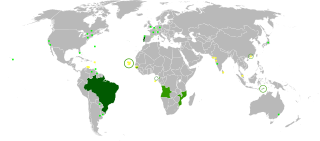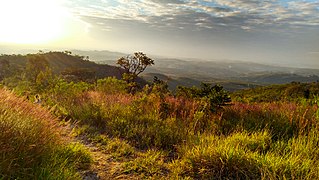
Sorocaba is a municipality in the state of São Paulo, Brazil. Sorocaba is the eighth-largest city in the state of São Paulo. Outside the Greater São Paulo region, it ranks behind only Campinas, São José dos Campos and Ribeirão Preto. It is part of the Metropolitan Region of Sorocaba. The population is 644,919 in an area of 450.38 km2.

Cesário Lange is a Brazilian municipality in the state of São Paulo. It is part of the Metropolitan Region of Sorocaba, and the statistical mesoregion of Itapetininga and microregion Tatuí. The population is 17,163 in an area of 190.39 km².

Piedade is a municipality in the state of São Paulo in Brazil. It is part of the Metropolitan Region of Sorocaba. The population is 54,717 in an area of 746.87 km². The elevation is 781 m.

Votorantim is a city located at the southwest of São Paulo State in Brazil. It is part of the Metropolitan Region of Sorocaba. The population is 117,794. The city is located about 100 km (62 mi) away from the capital of the state. It has 147 km2 (57 sq mi) of rural area, 30 km2 (12 sq mi) of urban area and a total area of 183.52 km2 (70.86 sq mi).
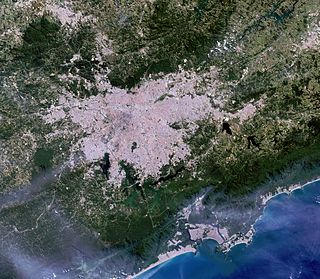
The Greater São Paulo is a nonspecific term for one of the multiple definitions the large metropolitan area located in the São Paulo state in Brazil.

The Rodovia José Magalhães Teixeira is the Campinas Beltway, a ring of high-speed highways surrounding the city of Campinas, in the state of São Paulo, Brazil. The Campinas Beltway is the Northern vertex of the Macrometropolitan Highway System of Greater São Paulo and one of the few complete metropolitan beltways in the country. It is an extensive structure, which directly interconnects 6 large double-lane highways to all quadrants of the state. Furthermore, it is superdimensioned, i.e., it has enough capacity to accommodate huge traffic loads without getting congested, even in peak hours.

Salto is a municipality in the state of São Paulo in Brazil. It is part of the Metropolitan Region of Sorocaba. The population is 114,171 in an area of 133.06 km². The elevation is 555 m. The city has one main river, rio Tietê. The city has an important geological park: "Moutonée Park".

Salto de Pirapora is a municipality in the state of São Paulo in Brazil. It is part of the Metropolitan Region of Sorocaba. The population is 43,574 in an area of 280.70 km2 (108.38 sq mi). The elevation is 630 m (2,070 ft).

Tietê is a Brazilian municipality in the state of São Paulo, located in the Metropolitan Region of Sorocaba, in the Meso-region of Piracicaba and in the Microregion of Piracicaba. It is located at latitude 23º06'07 "south and at a longitude 47º42'53" west, being at an altitude of 508 meters. Its estimated population in 2009 was 36 211 inhabitants. It has an area of 392,509 km2. This corresponds to a population density of 86.6 inhabitants/km2.

The Rodovia Senador José Ermírio de Moraes or SP-75 is a highway in the southeastern part of the state of São Paulo in Brazil. It begins in Sorocaba and ends at the SP-308 near Salto. It is also nicknamed Castelinho due to its similarity with Rodovia Castelo Branco.
The SP-79 is a highway in the southeastern part of the state of São Paulo in Brazil.

The Sorocaba River is a river of São Paulo state in southeastern Brazil. It is a tributary of the Tietê River. The river runs large and important part of the municipality of Sorocaba.
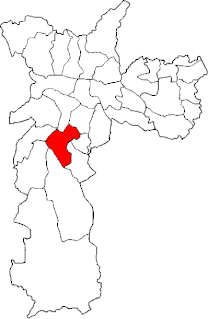
The Subprefecture of Santo Amaro is one of 32 subprefectures of the city of São Paulo, Brazil. It comprises three districts: Santo Amaro, Campo Belo, and Campo Grande.

Palmeiras-Barra Funda Intermodal Terminal is the second largest intermodal transportation hub in São Paulo, Brazil. The terminal has access to the São Paulo Metro, CPTM commuter rail, and numerous bus lines.
The São Francisco Ridge is a topographic elevation in the Brazilian Highlands, situated in the south of the cities of Votorantim and Sorocaba, state of São Paulo, Brazil.
Cruzeiro do Sul is the largest newspaper in Sorocaba city, São Paulo, Brazil. It was founded on June 12, 1903, by brothers Firmino Joaquim Pires de Camargo and João Clímaco Pires de Camargo. The publication began distributing the same year, initially four pages, with a bi-weekly circulation. It is owned and sponsored by the Ubaldino do Amaral Foundation-FUA.
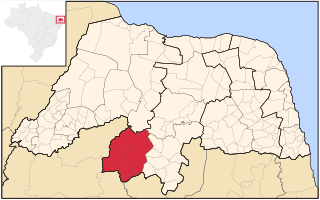
Seridó Ocidental is a microregion in the Brazilian state of Rio Grande do Norte.

The São Paulo Macrometropolis, also known as Expanded Metropolitan Complex is a Brazilian megalopolis that emerged through the existing process of conurbation between the São Paulo's metropolitan areas located around the Greater São Paulo, with more than 30 million inhabitants, or 74 percent of São Paulo State's population, is one of the most populous urban agglomerations in the world.
The Metropolitan Region of Sorocaba is an administrative division of the state of São Paulo in Brazil. It was created in 2014, and consists of the following municipalities:

